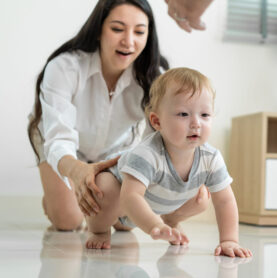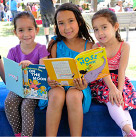Every child grows and develops differently, doing things at their own pace. While each child’s development is unique, there are certain milestones that many children reach at certain stages of life. Understanding these milestones gives parents and caregivers the chance to help their child develop new skills and reach their full potential. Don’t worry, every parent faces challenges and worries during this time. That’s why we’re committed to making the experience easier for parents with children of any age. In addition to the ages and stages listed below, CCRC offers a wide variety of programs, services, resources, and professionals who can help you build a healthy and happy family. If parents are every concerned about their child’s development, they should consult their family doctor or a child development professional.
Newborns
Newborn babies are amazing because each new day brings growth and development. From birth to 3 months, you will likely see your baby begin to improve her motor skills, react to loud noise, and begin to focus her eyes on your face. Babies at this age cry a lot, which can be overwhelming for parents. But these cries have meaning, and your baby may be in need of a diaper change, feeding, or a comforting embrace. Respond quickly to her cries to grow the bond with your baby and help her build confidence to self soothe in the future.
From birth to 3 months, I…
• Begin to smile at people
• Coo and make gurgling sounds
• Hold my head up and begin to push myself up when laying on my tummy
• Begin to act bored, getting fussy when we aren’t active
• Cry a lot but find comfort in sucking my hands or being cradled by you
• Grasp at a toy that’s held within reach
3 to 6 months
Babies at this age typically start to show some personality and may begin to act more social. Motor skills should be improving and many babies become more vocal. While every baby develops at a different pace, your baby should be smiling more often, babbling, and reaching for objects. You may start to notice your baby act more social and enjoy when familiar people hold or play with him. Many babies begin to cry more intentionally at this stage, using a different sounding cry for food versus a diaper change. Because he’s better at comforting himself now, your baby may not cry as often.
At 3 to 6 months, I…
– Like to play with people and get fussy when the play stops
– Smile spontaneously, especially at people
– Track movement with my eyes
– Recognize you and other familiar people and objects at a distance
– Cry in different ways
6 to 9 months
Not only do babies show off their personalities and affection at this stage, but they are much more involved in play time. This is the time when babies gain more control over their movement and begin interacting with others at a deeper level. While every baby develops in their own special way and at a unique pace, your baby should start adapting better to a routine like sleep and feeding. Cognitive and motor skills, as well as emotions and social skills, are developing more quickly now. This means babies are beginning to process more and become curious. Babies in this stage tend to spend more time investigating objects and exploring their environment, using their mouths to get information about texture, shape, and taste.
At 6 to 9 months, I…
– Start to sit up, move by rolling, and reach out more
– Transfer objects from one hand to the other
– Observe my surroundings often
– Like to play more, especially with you
– Know the difference between familiar people and strangers
9 to 12 months
As babies near the 1-year-old mark, they are eager to explore every inch of their surrounding world. Increased movement, constant reaching, and bringing objects to their mouth may become a regular occurrence. Many babies experience better hand-eye coordination and will test this by attempting to smash things together with both hands. Babies at this age begin to show their personalities in big ways and seek attention from others around them. This need for attention may include demands for you to read to him, play together, or simply carry him around and show him affection. As they become more familiar with language, some babies at this age begin trying out “mama” and “dada.”
At age 9 to 12 months, I…
– Move around the room by crawling and holding on to things to help me walk and scoot
– Copy sounds and gestures of others
– Enjoy playing games like patty-cake and peek-a-boo
– Start to shake my head “no” or wave “goodbye”
– Call for your attention by raising my voice
– Look for hidden objects
12 to 18 months
After celebrating the first year of life, babies blossom into curious, adventurous beings who want to explore the world around them. This age group is often referred to as a “toddler,” and marks a new stage of learning to use and understand more real words and attempting to walk independently. Simple words now connect for many toddlers, who may try to use some real words of their own, though it may only be recognizable to adults who spend a lot of time with them.
At age 12 to 18 months, I…
– Looks at the right picture or thing when it’s named
– Copy gestures
– Starts to use things correctly, like drinking from a cup or brushing my hair
– Follow simple directions like “pick up the toy” or “sit down”
– Play pretend in a simple way, such as feeding my baby doll
– Know what ordinary things are, like a phone, spoon, and car
18 to 24 months
This is the age when many toddlers seem to be making great leaps in communication and motor skills. Curiosity and confidence drive these developments and many toddlers begin using short sentences and walking more freely at this age. With this increased independence comes changes in behavior and many toddlers begin to show defiance and an “I want it my way” attitude. Toddlers may begin exploring on their own, engaging with the people around them, and testing their strength and balance with more physical activity. He may enjoy copying some of the chores you do by putting shoes in the closet, dropping clothes in a laundry basket, or stacking plates.
At age 18 to 24 months, I…
– Like to give things to others as part of my play time
– Explore on my own but not too far away from you
– Become nervous or uncomfortable around new people
– Speak more freely and use short sentences
– Walk, run, and climb
– Interact with other toddlers but mainly play around them
24 to 30 months
As toddlers get older, they use their growing language skills to communicate and begin to build friendships with other children and showing affection to familiar adults. Their physical skills, such as walking, running, and climbing, are improving at this point and that helps them explore the world in more adventurous ways. A curious toddler may become easily excited and distracted by something that enters their frame of view and they will probably enjoy telling you about what they see.
At age 24 to 30 months, I…
– Copy movements, words and sounds that people around me make
– Am more independent and like to do my own thing
– May be defiant if you tell me “no” or “stop”
– Play make believe games
– Know more words and can identify objects and animals in a book
– Find hidden objects, even if they’re under several layers


